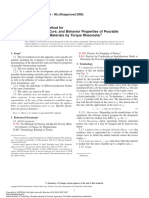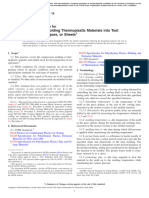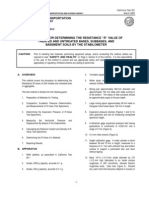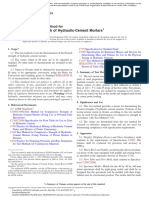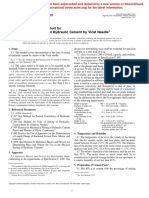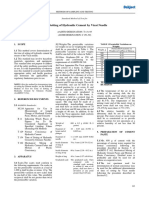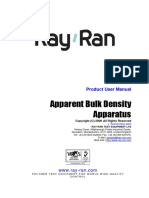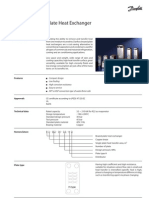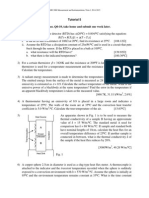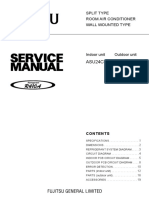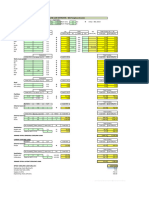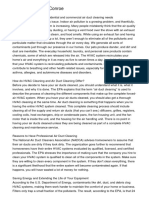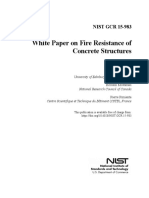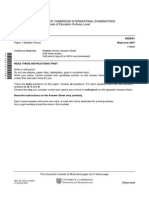Designation: D 731 – 95 (Reapproved 1999)
Standard Test Method for
Molding Index of Thermosetting Molding Powder1
This standard is issued under the fixed designation D 731; the number immediately following the designation indicates the year of
original adoption or, in the case of revision, the year of last revision. A number in parentheses indicates the year of last reapproval. A
superscript epsilon (e) indicates an editorial change since the last revision or reapproval.
1. Scope This force along with the mold closing time is reported as
1.1 This test method covers the measurement of the molding molding index.
index of thermosetting plastics ranging in flow from soft to stiff 5. Significance and Use
by selection of appropriate molding pressures within the range
from 4.1 to 31.9 MPa. 5.1 This test method provides a guide for evaluating the
1.2 The values stated in SI units are to be regarded as moldability of thermosetting molding powders. This test
standard. method does not necessarily denote that the molding behavior
1.3 This standard does not purport to address all of the of different materials will be alike and trials may be necessary
safety concerns, if any, associated with its use. It is the to establish the appropriate molding index for each material in
responsibility of the user of this standard to establish appro- question.
priate safety and health practices and determine the applica- 5.2 The sensitivity of this test diminishes when the molding
bility of regulatory limitations prior to use. pressure is decreased below 66 MPa, so pressures lower than
this are not ordinarily recommended. This is due to the friction
NOTE 1—There is no ISO standard equivalent to this test method. of moving parts and the insensitivity of the pressure switch
2. Referenced Documents actuating the timer at these low pressures.
2.1 ASTM Standards: 6. Apparatus
D 256 Test Methods for Impact Resistance of Plastics and 6.1 Mold—A cup mold4 of the flash type, to produce a
Electrical Insulating Materials2 molded cup as shown in Fig. 1, operated under controlled
D 883 Terminology Relating to Plastics2 pressure and temperatures and provided with stops so that flash
D 957 Practice for Determining Mold Surface Temperature or fin thickness cannot be less than 0.14 mm. The area of the
of Molds for Plastics2 mold casting creating the molded flash shall be located on top
E 691 Practice for Conducting an Interlaboratory Study to of the cup, flat, perpendicular to the axis of the cup, and in the
Determine the Precision of a Test Method3 form of an annular ring 3.17 mm (0.125 in.) in width.
3. Terminology 6.2 Thermometer—A 32-mm partial-immersion mercury
thermometer having a diameter just under 4.8 mm and a
3.1 Definitions: Definitions are in accordance with Termi- temperature scale of not more than 20°C/25.4 mm of length. A
nology D 883, unless otherwise specified. pyrometer may be used to determine the temperature of the
4. Summary of Test Method mold surfaces. For properly measuring mold temperatures,
reference should be made to Practice D 957.
4.1 A cup mold is mounted in a semi-automatic type press. 6.3 Heating System—Any conventional means for heating
A predetermined quantity of test sample is charged into the the press platens, provided the heat source is constant enough
mold, controlled at a temperature dependent upon the test to maintain the molding temperature within 61°C of the
material. The minimum force required to mold a cup having a specified temperature (see 9.2).
flash or fin thickness within a specified tolerance is determined. 6.4 Pressure System—A semiautomatic press with a fixed
mold and fully insulated to minimize heat losses shall be used.
The use of hand molds is not recommended but may be used to
1
give an estimate of the molding index. The hydraulic system
This test method is under the jurisdiction of ASTM Committee D-20 on Plastics
and is the direct responsibility of Subcommittee D 20.30 on Thermal Properties shall be provided with a means of pressure regulation so that
(Section D20.30.08). the load on the mold shall differ by not more than 656.2 N
Current edition approved Feb. 15, 1995. Published April 1995. Originally
published as D 731-50. Last previous edition D 731-90.
2 4
Annual Book of ASTM Standards, Vol 08.01. A detailed drawing of the mold design is available from ASTM Headquarters.
3
Annual Book of ASTM Standards, Vol 08.03. Order Adjunct: ADJD0731.
Copyright © ASTM International, 100 Barr Harbor Drive, PO Box C700, West Conshohocken, PA 19428-2959, United States.
1
� D 731
preserve the original moisture content. Alternative methods of
conditioning samples may be used provided they are mutually
agreed upon between the manufacturer and the purchaser.
NOTE 3—Conditioning may alter the moisture content of most materials
and thereby change their molding index or molding behavior.
9. Procedure
9.1 Mount the mold in a press of the semi-automatic type.
Past experience has shown that the rate of flow is sensitive to
the condition of the mold surfaces; preceding materials may
have deposited a film that influences the mold surfaces to the
extent that erroneous results may be obtained unless properly
conditioned prior to testing. A suggested procedure is to
discard the first few cups molded and accept the flow time as
correct when two successive cups molded under test do not
differ by more than 1 s in time of flow.
9.2 The preferred mold temperature for testing the molding
index for the following materials shall be:
°C
Phenolic 165 6 1
FIG. 1 Cup Mold Melamine 155 6 1
Urea 150 6 1
Epoxy 150 6 1
Diallyl phthalate 1506 1
from the stated value. The capacity of the hydraulic system Alkyd 150 6 1
shall permit a ram travel of approximately 25 mm/s. It is
recommended that the ram diameter not exceed 100 mm. Other temperatures may be used as agreed upon between the
manufacturer and the purchaser.
7. Test Specimen 9.3 First determine the proper weight to be used as outlined
7.1 To determine the weight of the test specimen for in 6.1. Then begin the test with a load sufficient to close the
materials having an Izod impact strength of 27 J/m of notch, or mold to the fin thickness specified for the type of material
less, a cup having a flash or fin thickness of 0.15 to 0.20 mm being tested as defined in 6.1. For example, if a 2248 N load is
shall be molded (see Note 3). The adhering fin shall be applied on the mold to make the initial cup and the required fin
removed and the cup weighed to the nearest 0.1 g. This weight thickness is obtained, the next lower load, 1686 N is applied as
multiplied by 1.1 shall be the weight of the test specimen used. indicated in the following table. If the mold closes to the
For materials having an impact above 27 J/m of notch, the required thickness again, then the 1124 N load is applied. If the
specimen weight is determined in a similar manner, except that mold then does not close, the “molding index” is the closing
cup flash shall not be more than 0.66 mm or less than 0.51 mm time obtained with the 1686 N load. It is recommended that the
and the amount of material shall be 1.05 times the weight of mold loads used be selected from the following table:
this cup. The test specimen shall be in the form of loose powder Total Load Molding Pres-
sure
unless preforming is necessary for materials of high bulk. N MPa
Minimum pressure shall be employed in the preforming
operation to minimize the increase in closing time resulting 1112 4.6
1601 6.6
from the use of preforms. 1124 9.0
1686 13.6
NOTE 2—While the mold is provided with stops so that the flash or fin
2248 18.0
thickness cannot be less than 0.15 6 0.013 mm, the molded cup itself may 3372 21.2
have a flash thickness of 0.15 to 0.20 mm as the micro switch controlling 4496 36.3
the closing time must have a tolerance in which to operate. 11 120 45.4
8. Conditioning 9.4 The time of flow in seconds shall be measured from the
8.1 Materials are normally tested in the “as received” instant that the hydraulic gage indicates an applied load of 454
condition, except in referee tests, when they shall be condi- kg to the instant that the fin has reached 0.20 mm in thickness
tioned in accordance with 8.2 (see Note 2). for materials with an Izod impact strength of 27 J/m of notch,
8.2 For referee testing, all materials shall be shipped and or less, and 0.66 mm for materials with an impact above 27 J/m
stored in sealed moisture barrier containers. These materials of notch.
shall be stored for a minimum period of 48 h at standard NOTE 4—The molding pressure is calculated by dividing the total load
laboratory temperature before breaking the seal on the carton. by the projected area of the mold cavity.
A representative sample shall be taken from this carton NOTE 5—A convenient method for determining fin thickness is to
immediately after opening and tested within 3 min in order to indicate the final movement of the platen with a dial micrometer.
2
� D 731
TABLE 1 Molding Index in Seconds accordance with Practice E 691 involving ten test samples. The
NOTE 1—Sr is the within-laboratory standard deviation of the average, test results in Table 1 were from 4 laboratories with each
SR is the between-laboratories standard deviation of the average, r = 2.8 laboratory obtaining four test results for each sample.
Sr, and R = 2.8 S R.
NOTE 6—Caution: The following explanations of r and R (11.3
Material Average Load, N Sr SR r R
through 11.3.3) are only intended to present a meaningful way of
Polyester (B)B 4.78 1124 0.025 0.909 0.070 2.545 considering the approximate precision of this test method. The data in
Glass-Filled (B)A 8.99 1124 0.038 0.727 0.106 2.036
Polyester (A)B 9.63 1124 0.072 0.577 0.202 1.616
Table 1 should not be rigorously applied to the acceptance or rejection of
Mineral Filled (A)A 11.54 1124 0.072 0.881 0.202 2.467 material, as those data are specific to the round robin and may not be
Mineral Filled (B)B 11.57 1124 0.098 1.736 0.274 4.861 representative of other lots, conditions, materials, or laboratories. In
General Purpose (B)B 11.78 1124 0.041 1.264 0.115 3.539 particular with data from less than six laboratories, the between-
DAP (B)B 12.64 1124 0.054 0.892 0.151 2.498 laboratories results are likely to have a very high degree of error.
Impact Type (B)B 14.92 1686 0.090 0.965 0.252 2.702
Glass-filled (A)A 16.06 2248 0.083 0.912 0.232 2.554
General Purpose (A)A 18.37 1686 0.056 1.331 0.157 3.727
11.2 Users of this test method should apply the principles
A
outlined in the 1987 edition of Practice E 691 to generate data
Sample B obtained from Occidental Chemical Corp., Fort Green, Ontario,
Canada. specific to their laboratory and materials or between specific
B
Sample A obtained from Occidental Chemical Corp., Tonawanda, NY. laboratories. The principles of 11.3 through 11.3.3 would then
be valid for such data.
10. Report
11.3 Concept of r and R—If Sr and S R have been calculated
10.1 Report the following information: from a large enough body of data, (use Table 1 with caution as
10.1.1 A statement indicating the nature of the material only four laboratories participated) and for test results that
tested and the manufacturer’s material number and batch were averages from testing four specimens.
number,
11.3.1 Repeatability Limit, r—Comparing two test results
10.1.2 The molding index expressed as the total minimum
for the same material, obtained by the same operator using the
force in newtons required to close the mold, with the closing
same equipment on the same day, the two test results should be
time in seconds as a subscript (for example, 337218 N),
10.1.3 Temperature of the mold, judged not equivalent if they differ by more than the r value for
10.1.4 Weight of the test sample in grams, and form of that material.
sample (loose powder or preform), 11.3.2 Reproducibility Limit, R—Comparing two test results
10.1.5 Thickness of flash or fin measured to the nearest for the same material, obtained by different operators using
0.025 mm (0.001 in.), different equipment on different days, the two test results
10.1.6 Description of any unusual characteristics of the test should be judged not equivalent if they differ by more than the
sample, such as discoloration and sticking, R value for that material.
10.1.7 Details of conditioning, 11.3.3 Any judgment in accordance with 11.3.1 and 11.3.2
10.1.8 Impact strength of the material expressed as Izod in would have an approximate 95 % (0.95) probability of being
joules per metre of notch in accordance with Test Methods correct.
D 256, and
11.4 Bias is systematic error that contributes to the differ-
10.1.9 Indicate if preforms were necessary to run the test.
ence between a test result and a true (or reference) value. There
11. Precision and Bias 5 are no recognized standards on which to base an estimate of
11.1 Table 1 is based on a round robin conducted in 1988 in bias for this test method.
5
12. Keywords
Supporting data are available from ASTM Headquarters. Request RR: D-20 -
1163. 12.1 molding index; thermosets
ASTM International takes no position respecting the validity of any patent rights asserted in connection with any item mentioned
in this standard. Users of this standard are expressly advised that determination of the validity of any such patent rights, and the risk
of infringement of such rights, are entirely their own responsibility.
This standard is subject to revision at any time by the responsible technical committee and must be reviewed every five years and
if not revised, either reapproved or withdrawn. Your comments are invited either for revision of this standard or for additional standards
and should be addressed to ASTM International Headquarters. Your comments will receive careful consideration at a meeting of the
responsible technical committee, which you may attend. If you feel that your comments have not received a fair hearing you should
make your views known to the ASTM Committee on Standards, at the address shown below.
This standard is copyrighted by ASTM International, 100 Barr Harbor Drive, PO Box C700, West Conshohocken, PA 19428-2959,
United States. Individual reprints (single or multiple copies) of this standard may be obtained by contacting ASTM at the above
address or at 610-832-9585 (phone), 610-832-9555 (fax), or service@astm.org (e-mail); or through the ASTM website
(www.astm.org).


